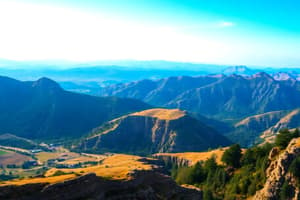Podcast
Questions and Answers
Which of the following is an example of qualitative data?
Which of the following is an example of qualitative data?
- Measurements of temperature
- Survey interviews (correct)
- Population sizes
- Statistical analysis
Spatial interaction refers to the physical distance between places.
Spatial interaction refers to the physical distance between places.
False (B)
Name one application of geography that involves preparing for natural disasters.
Name one application of geography that involves preparing for natural disasters.
Disaster management
____ analysis identifies the distribution of features across space.
____ analysis identifies the distribution of features across space.
Match the following geographical applications with their descriptions:
Match the following geographical applications with their descriptions:
Which branch of geography focuses on the impacts of human activities on the environment?
Which branch of geography focuses on the impacts of human activities on the environment?
Absolute location uses qualitative descriptions to specify a place's position.
Absolute location uses qualitative descriptions to specify a place's position.
What does the term 'region' refer to in geography?
What does the term 'region' refer to in geography?
The study of climate and landforms falls under the category of __________ geography.
The study of climate and landforms falls under the category of __________ geography.
Match the following geographic terms with their definitions:
Match the following geographic terms with their definitions:
Which of the following is NOT a type of region?
Which of the following is NOT a type of region?
Geographic Information Systems (GIS) are used to analyze spatial data.
Geographic Information Systems (GIS) are used to analyze spatial data.
What is diffusion in the context of geography?
What is diffusion in the context of geography?
Flashcards
Qualitative Data
Qualitative Data
Descriptive information that can't be measured numerically, like observations or interviews.
Quantitative Data
Quantitative Data
Numerical information used in statistics, like population counts.
Spatial Patterns
Spatial Patterns
How things are arranged on Earth.
Spatial Processes
Spatial Processes
Signup and view all the flashcards
Urban Planning
Urban Planning
Signup and view all the flashcards
Geography
Geography
Signup and view all the flashcards
Physical Geography
Physical Geography
Signup and view all the flashcards
Human Geography
Human Geography
Signup and view all the flashcards
Location (Geography)
Location (Geography)
Signup and view all the flashcards
Region
Region
Signup and view all the flashcards
Movement (Geography)
Movement (Geography)
Signup and view all the flashcards
Human-Environment Interaction
Human-Environment Interaction
Signup and view all the flashcards
Geographic Information Systems (GIS)
Geographic Information Systems (GIS)
Signup and view all the flashcards
Study Notes
Introduction to Geography
- Geography is the study of Earth's physical features, processes, and human activities.
- It encompasses both the natural and human aspects of our planet.
- Geographic inquiry involves describing, explaining, and predicting spatial patterns and processes.
- It investigates how people, places, and environments interact.
Branches of Geography
- Physical Geography: Examines the Earth's natural processes and phenomena.
- Includes the study of climate, weather patterns, landforms, water resources, soils, ecosystems, and natural hazards.
- Human Geography: Focuses on human activities and their impacts on the environment.
- Includes population distribution, migration patterns, economic activities, urbanization, cultural landscapes, and political organizations.
Key Concepts in Geography
- Location: Describes the position of a place on Earth.
- Absolute location: uses coordinates (latitude and longitude) to pinpoint a place.
- Relative location: describes a place's position in relation to other places.
- Place: Refers to the unique characteristics that distinguish a location.
- Physical characteristics: landforms, climate, vegetation.
- Human characteristics: culture, history, population density.
- Region: Area with shared characteristics.
- Formal region: defined by shared physical or cultural traits (e.g., climate zone, language region).
- Functional region: characterized by a set of interactions and connections (e.g., a metropolitan area, a trade area).
- Vernacular region: defined by popular perception (e.g., "the South," "the Midwest").
- Movement: Describes the flow of people, goods, ideas, and information.
- Spatial interaction: how places connect and exchange.
- Diffusion: the spread of phenomena over space and time.
- Human-Environment Interaction: Studies the relationship between humans and their environment.
- How human activities modify the environment and vice versa.
- How environmental factors influence human activities.
Geographic Tools and Techniques
- Maps: Visual representations of the Earth's surface.
- Different types of maps (physical, political, thematic).
- Geographic Information Systems (GIS): Software used to analyze spatial data.
- Allows the overlay and analysis of different datasets.
- Remote Sensing: Gathering data from a distance using technologies.
- Satellites, aerial photography are examples.
- Fieldwork: Collecting data through direct observation and measurement in the field.
- Qualitative Data: descriptive information, not measurable, like interviews, observations.
- Quantitative Data: numerical information used in statistical analysis, like population sizes.
Spatial Analysis in Geography
- Spatial patterns: Distribution of features across space.
- Spatial processes: Forces and interactions that shape patterns.
- Spatial interaction: Exchanges between places.
Applications of Geography
- Urban planning: Designing and managing urban areas.
- Environmental management: Protecting and restoring ecosystems.
- Disaster management: Preparing for and responding to natural disasters.
- Resource management: Efficient use of natural resources.
- Global change studies: Addressing issues like climate change and biodiversity loss.
Conclusion
- Geography is an interdisciplinary field that provides valuable insights into the Earth's features and processes, both natural and human-induced.
- It emphasizes the interconnectedness of places and the importance of spatial patterns in understanding the world.
Studying That Suits You
Use AI to generate personalized quizzes and flashcards to suit your learning preferences.




